LAII Maya Art and Archaeology Tour
July 9, 2018 - Robyn Côté
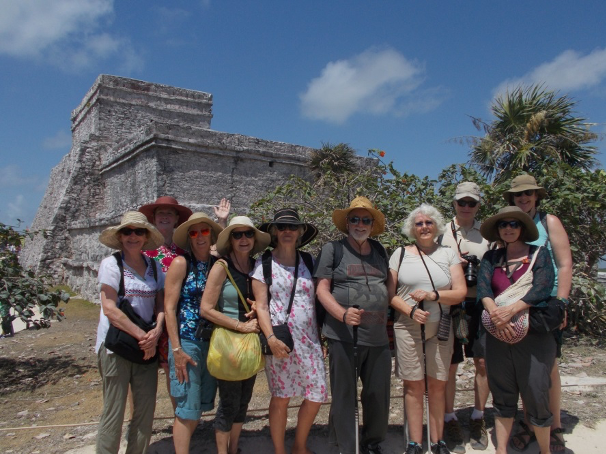
From May 11 to May 20, 2019, UNM’s Latin American and Iberian Institute (LAII) led a group of 9 community members on a new and innovative Maya Art and Archaeology Tour through the Mexican states of Chiapas, Campeche, and Quintana Roo visiting 10 Maya Pre-Colombian sites and several modern-day Maya communities. Part of the LAII’s Community Trips Abroad Program, this was the first time that the LAII led a tour to Mexico with an art historical/archaeological theme. The nine community members were accompanied by UNM Associate Professor of Art History Dr. Margaret Jackson and LAII Program Manager Manon Robyn Côté on the 10-day tour through the Chiapas highlands, the jungle and rainforest of Campeche state near the Guatemalan border, and the Caribbean Coast of Quintana Roo to visit some lesser-known and therefore less-frequented Maya archaeological sites.
On-the-ground tour logistics were arranged by Ecoturismo Yucatán, a tour company based in Merida, Yucatán, according to the itinerary developed by Ms. Côté and Dr. Jackson. Ecoturismo subcontracted local tour guide Sergio Flores López and chauffer Julio Cruz Mandujano who accompanied the group for the duration of the tour.
Day 1: Travel to Mexico This was a travel day, but some of the group arrived in San Cristobal early and were able to have one more day of activities including visiting the Amber Museum, walking the streets of San Cristobal, and visiting the Na Bolom Cultural Center and the Centro de Textiles del Mundo Maya, among other activities.

Marimba in Museo del Ambar Lilia Mijangos, San Cristobal de las Casas
(photo courtesy of Margaret Jackson)
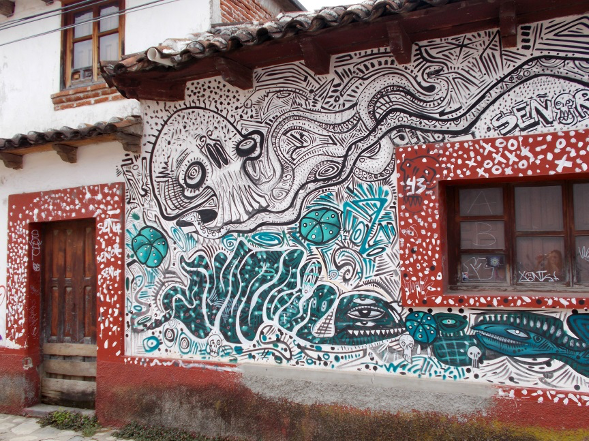
Street art, San Cristobal de las Casas (photo courtesy of Manon Robyn Côté)
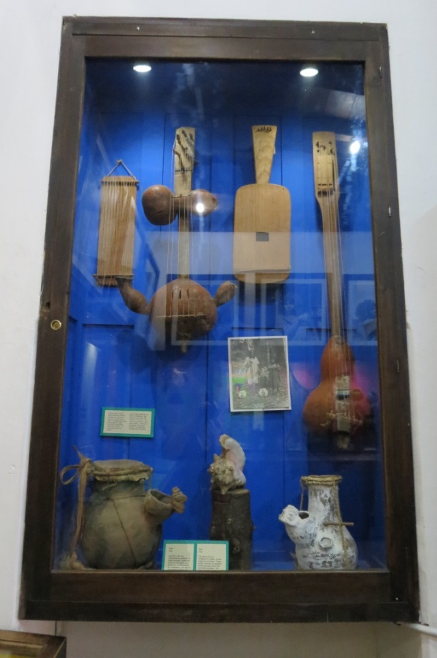
Lacandon Indian instruments in Na Bolom Cultural Center
(photo courtesy of Margaret Jackson)
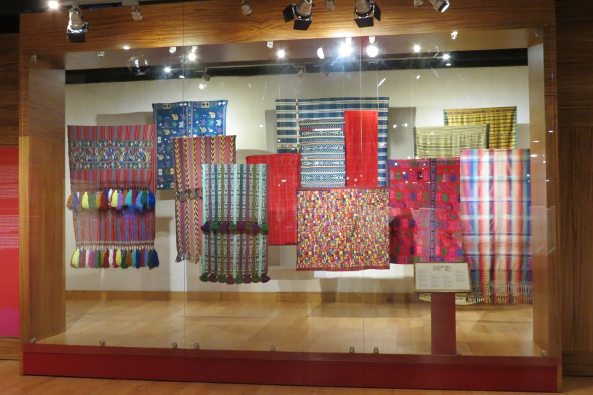
Centro de los Textiles del Mundo Maya, San Cristobal de las Casas
(photo courtesy of Margaret Jackson)
Day 2: San Cristobal de las Casas The first full day of the tour began in the Maya highland town of San Cristobal de las Casas. Founded in 1528, the town is the cultural center of the state of Chiapas. While it maintains its Spanish colonial layout and architecture, it is also an important trade and governmental center for the surrounding indigenous communities, who refer to the town by its Tzotzil name Jovel. The group toured the municipal marketplace where participants could see how an everyday market, not intended for tourists operates, then visited the local tianguis or market stalls filled with beautiful contemporary weavings. There we met with Haydeé Orea, professional restorator with the Instituto Nacional de Antropologia e Historia (INAH) who gave us a detailed description of how her team restored the ornate Baroque façade of the Santo Domingo church, which was built in 1551. Unfortunately this church, like many in San Cristobal, was closed due to severe earthquake damage from the 2017 magnitude 8.1 earthquake that affected the area, so we were unable to see the interior. The group then went to the Centro Cultural TierrAdentro Café which is owned and operated by Zapatista supporters to hear a fascinating lecture by Dr. Peter Rossett, Professor of Agroecology at the Colegio de la Frontera del Sur (ECOSUR) in San Cristobal, about the local Zapatista movement and the effects of climate change on local agricultural. Dr. Rossett gave the group an overview of the history of the Zapatista movement and also talked about current conflicts between the Zapatistas and the Mexican government as well as conflicts with local mestizo communities. His background in agroecology incorporated vital information about how climate change is affecting food production in the area and the need for public education to protect the environment and to aid the Zapatistas in their struggle toward achieving economic sovereignty and resiliency.
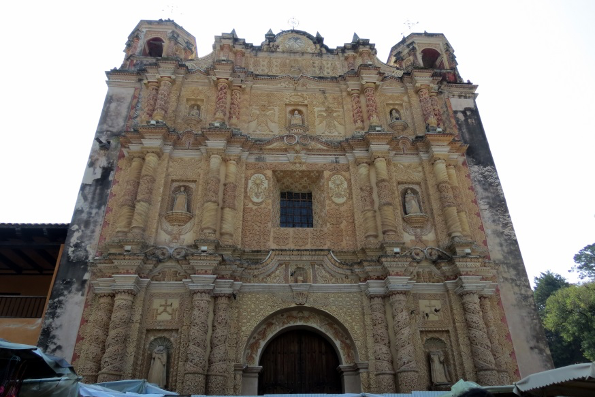
Façade of Santo Domingo Church, circa 1551, San Cristobal de las Casas
(photo courtesy of Margaret Jackson)
The group then visited the nearby Tzotzil Maya community of Zinacantán which means “land of bats,” where they met a local family that produces, spins, and weaves its own wool into beautiful weavings and clothing. The matriarch of the family has been named a “Living Treasure” by UNESCO. Her daughter gave a demonstration of how to card and spin wool, and some of the tour participants tried their hand at spinning their own yarn.
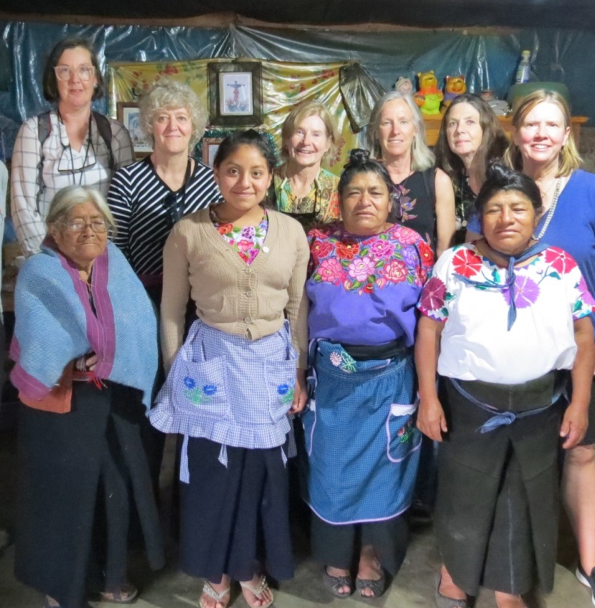
Group in Tzotzil community of Zinacantán (photo courtesy of Margaret Jackson)
The day ended under an immense thundershower in the fiercely independent Tzotzil community of San Juan Chamula where the group visited its unusual church which incorporates pre-conquest Maya customs and Spanish Catholic traditions, resulting in an ethereal syncretism. Participants were enchanted by the candles and copal incense burning in the church, where the floor is covered with pine boughs and needles, and curanderos perform healing rituals surrounded by statues of Catholic saints adorned with mirrors. There is no altar or priest associated with the church. Photography is strictly prohibited and residents have been known to take matters into their own hand, confiscating cameras or escorting violators out of town.
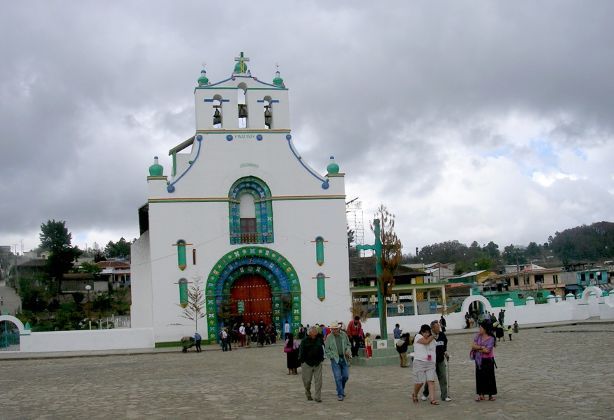
Church in San Juan Chamula, circa 1524 (photo courtesy of Manon Robyn Côté)
Day 3: Toniná Day 3 was primarily a travel day. The group left San Cristobal early for a 2 hour drive to the archaeological site of Toniná (1 AD – 1000 AD) near the modern-day town of Ocosingo. Toniná was one of the most aggressive Maya city-states during the Late Classic period, rivaling and capturing victims from neighboring sites such as Piedras Negras, the powerful Calakmul, and the well-known site of Palenque, which it eventually defeated in 764 AD. The site is home to a large ballcourt and to one of the tallest pyramids in Mexico, rising 243 feet above the central plaza. Built upon 7 terraces, the acropolis, which at one time looked like nothing more than one of the hills in the area, was excavated in the 1970s and 1980s to reveal the enormous structure we see today. Many well-preserved limestone stucco friezes were placed strategically along the different levels, documenting the defeat and capture of its neighbors, and several in-the-round carved statues and monuments commemorating Toniná’s kings and leaders were found on the structure. Most of these sculptures are now in the Toniná Museum, which unfortunately was closed to the group because it was Monday. After exploring the site the group continued on the 3 hour drive to the town of Palenque passing indigenous, mestizo, and Zapatista villages along the way.
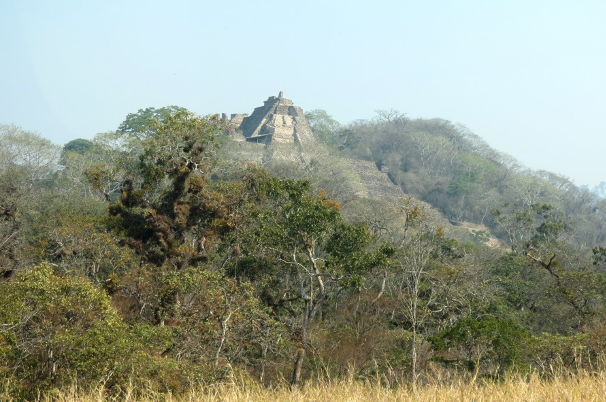
The acropolis at Toniná (photo courtesy of Margaret Jackson)
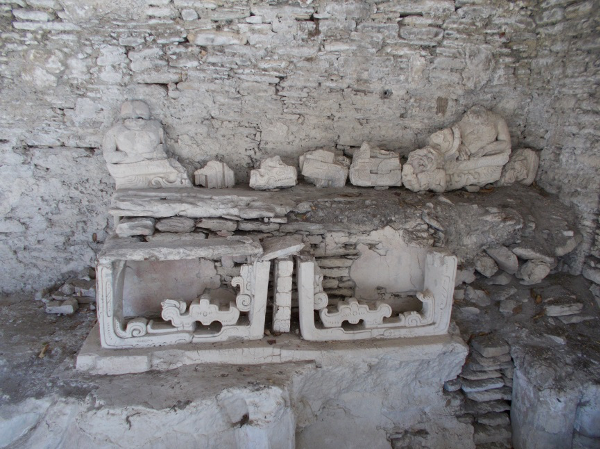
Limestone Stucco Relief Frieze at Toniná (photo courtesy of Manon Robyn Côté)
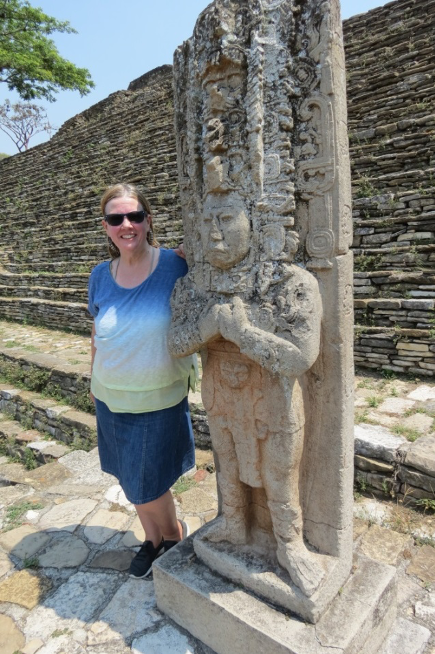
Dr. Jackson with monument to 6th century ruler Jaguar Bird Peccary, Toniná
(photo courtesy of Margaret Jackson)

Photo of Ejido Adolfo Ruiz Cortinez, Zapatista Community
(photo courtesy of Manon Robyn Côté)
Day 4: Palenque To beat the 100 degree heat the group left early for the archaeological site of Palenque (250 BC – 900 AD) where they spent the morning visiting the “Palace” and the “Cross Group” and learned about the Late Classic dynasty of K’inich Janaab’ Pakal - one of the most famous Maya kings who ascended the throne at the age of 12 and ruled the site of Palenque for 68 years - his wife the Red Queen Lady Tzákbu Ajaw, and his sons Kan Bahlam II and Kan Joy Chitam II. After touring the site the group visited the Palenque Museum where they met briefly with Museum Director Miguel Angel Vásquez del Mercado and saw the magnificent reproduction of Pakal’s tomb with its impressive sarcophagus and complete description of the iconography associated with the tomb. The group also viewed beautiful carved limestone reliefs and the enormous collection of incense burners and other items which were found at the site.

Tomb of the Red Queen next to Pakal’s tomb, the Temple of the Inscriptions, Palenque
(photo courtesy of Manon Robyn Côté)
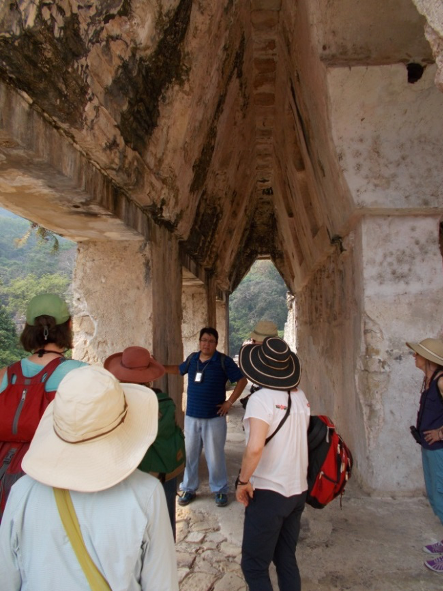
Group with tour guide Sergio Flores López inside the “Palace,”
Palenque (photo courtesy of Manon Robyn Côté)
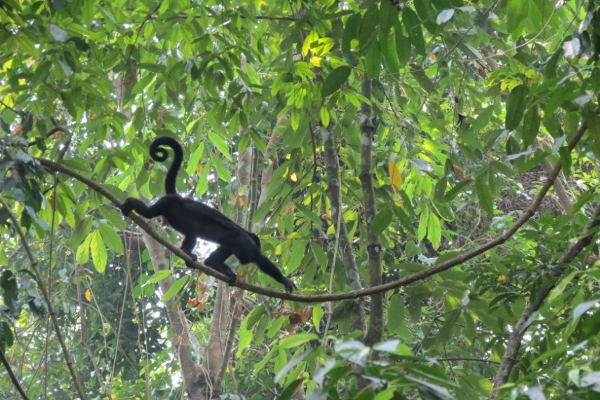
Howler monkey, Zona Arqueológica Palenque
(photo courtesy of Margaret Jackson)
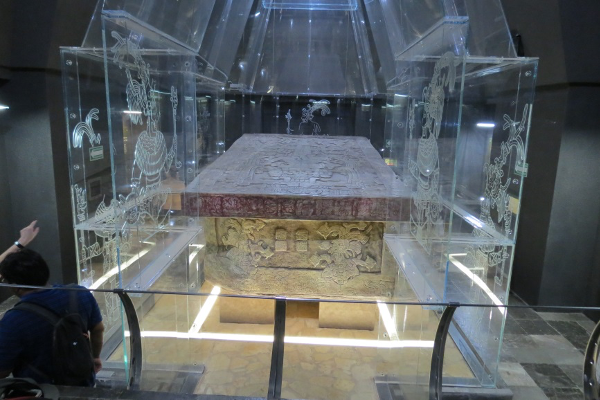
Reproduction of Pakal’s tomb inside the Palenque Museum
(photo courtesy of Margaret Jackson)

Inscensario inside Museum of Palenque
(photo courtesy of Margaret Jackson)
Day 5: Hormigüero and Zoh Laguna After visiting Palenque the group headed east for a 5 hour drive through the states of Tabasco and Campeche near the Petén region and the border with Guatemala. Before arriving at their destination in the tiny community of Zoh Laguna near the town of Xpujil the group stopped at the archaeological site of Hormigüero (300 AD – 950 AD) where they visited a Late Classic structure with a colossal Chenes-style earth monster mouth portal, and a smaller Chenes-style structure.
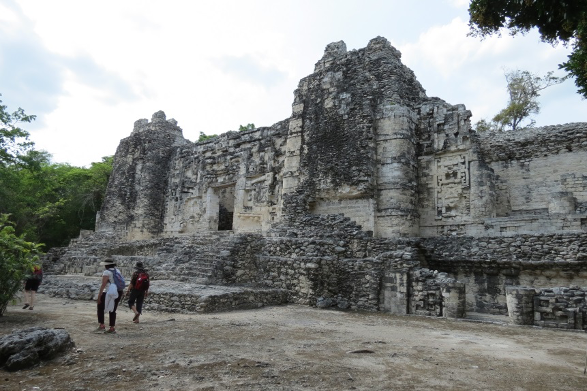
Hormigüero archaeological site (photo courtesy of Margaret Jackson)
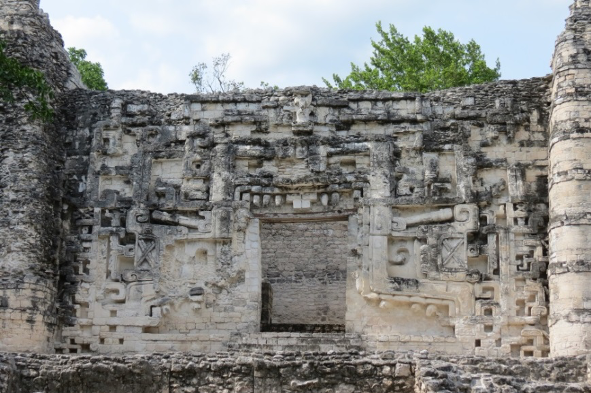
Hormigüero, Chenes-style Earth Monster mouth portal
(photo courtesy of Margaret Jackson)
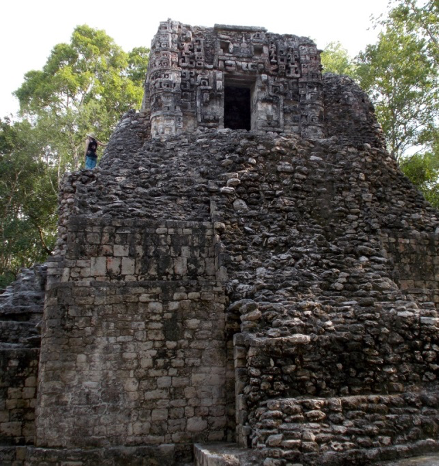
Chenes style structure at Hormigüero (photo courtesy of Manon Robyn Côté)
Day 6: Chicanná, Becán, and Xpuhil Day 6 consisted of visiting some of the local Chenes or Rio Bec style sites that are located close to the town of Xpujil. Each site has its own particular style of architecture: Chicanná (200 BC – 1100 AD) with its earth-monster mouth portal temple dominating the site, intermixed with residential structures; Bécan (600 BC – 1000 AD) a moated city which dominated the area the longest period of time, with its false pyramid façades simulating the steep steps and facades of Rio Bec style of architecture; and Xpuhil (300 BC – 1200 AD) with its 3 towers typical of the Rio Bec style of architecture.
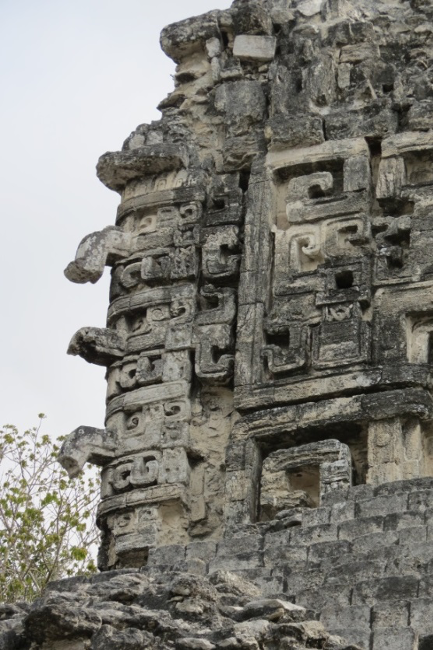
Chicanná chaac or witz architectural elements (photo courtesy of Margaret Jackson)
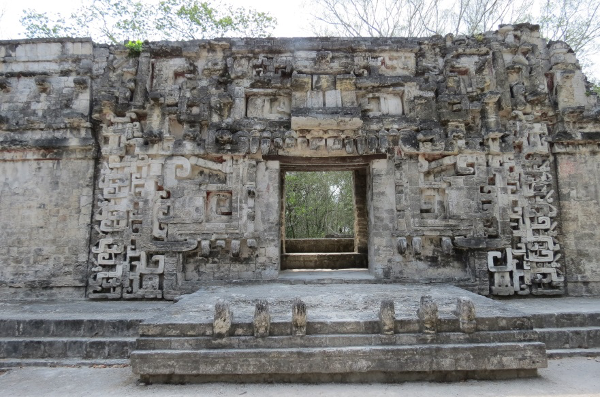
Chicanná Earth Monster Mouth portal (photo courtesy of Margaret Jackson)
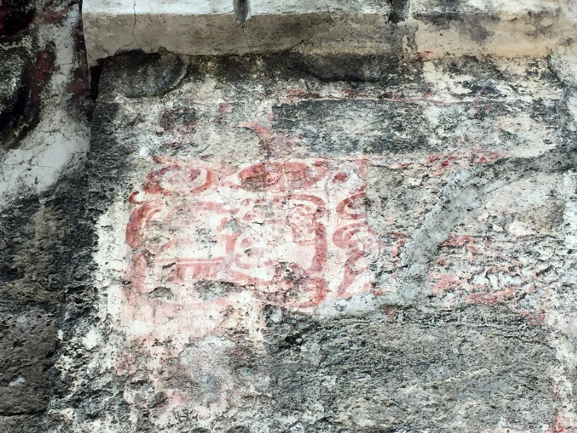
Remnants of painted Maya glyphs at Chicanná
(photo courtesy of Manon Robyn Côté)

Becán structure (photo courtesy of Margaret Jackson)
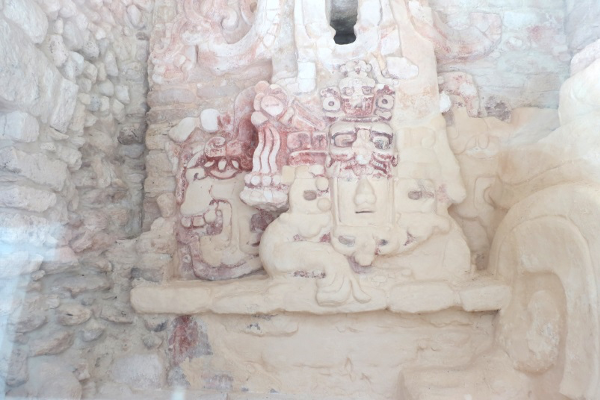
Frieze at Becán (photo courtesy of Margaret Jackson)
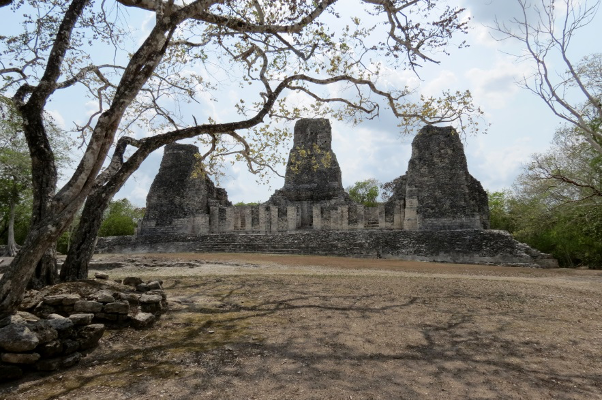
Rio Bec style site of Xpuhil (photo courtesy of Manon Robyn Côté))
Day 7: Calakmul and Balamkú Once again, to beat the heat the group left very early for the great site of Calakmul (250 BC – 900 AD), home of the “Ka’an” or “Snake” dynasty, one of the largest and most powerful city-states in the Maya region. In Conhuás the group switched vehicles for the ride into the Calakmul Biosphere Reserve, seeing wild turkeys and koatimundis along the way. Calakmul is an enormous site and the group was only able to visit a small part of it, focusing on the Acropolis and Great Plaza. The group was hoping to see the murals inside the pyramid of Chiik Nahb but unfortunately the structure was closed to the public. Members of the group climbed several pyramids, including Structures I and Structure II, known to be the tallest pyramid on the Yucatán Peninsula, and Structure VII which also has a commanding view of the Biosphere Reserve. After returning from Calakmul the group visited the site of Balamkú (600 BC – 1000 AD), known for its amazing stucco relief frieze dating to about 600 AD. The relief combines imagery of the underworld with aquatic elements, including snakes, amphibians and jaguars, and conflates the solar cycle with the dynastic history of its king.
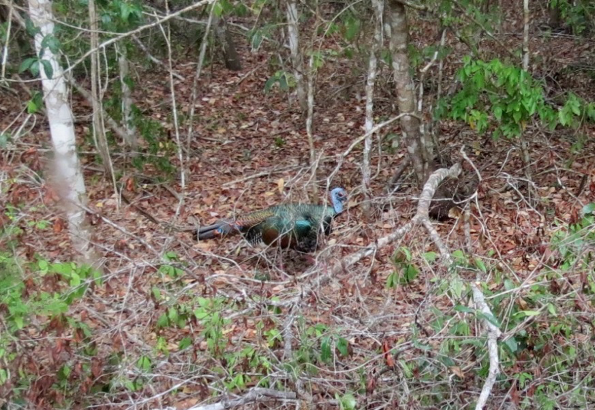
Wild Turkey, Calakmul Biosphere Reserve
(photo courtesy of Margaret Jackson)
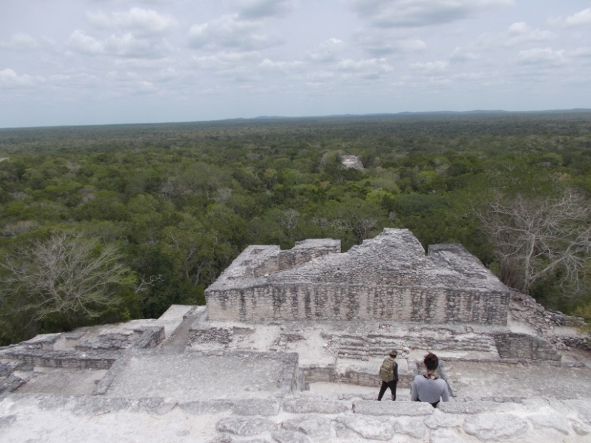
View from the top of Structure II, Calakmul
(photo courtesy of Manon Robyn Côté)

Members of the group on top of Structure VII at Calakmul
(photo courtesy of Margaret Jackson)
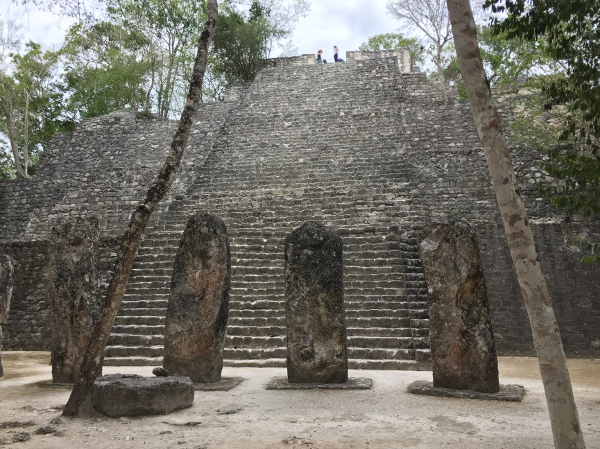
Stelae at the bottom of Structure VII, Calakmul
(photo courtesy of Manon Robyn Côté)
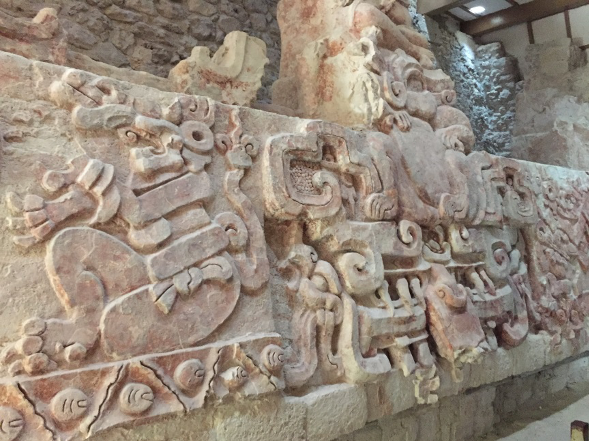
Stucco frieze at Balamkú (photo courtesy of Manon Robyn Côté)
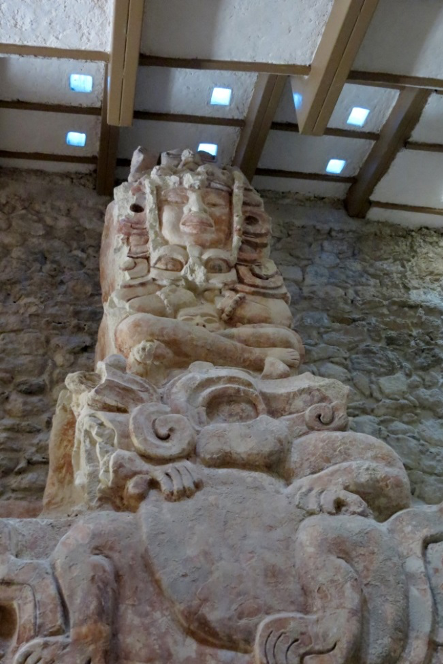
The king represented by 4 faces, Stucco Frieze at Balamkú
(photo courtesy of Margaret Jackson)
Day 8: 20 de noviembre, Kohunlich, Laguna Bacalar On the 8th day of the trip the group traveled east and then north to its next and last location. The group stopped first at the ejido of 20 de noviembre, a small Maya community which contains a burgeoning ecotourism industry where locals produce and sell jewelry made from local seeds and feathers. Participants were also able to purchase medicinal honey and cosmetics produced from the honey of the stingless Melipona bee, which is native to the area.
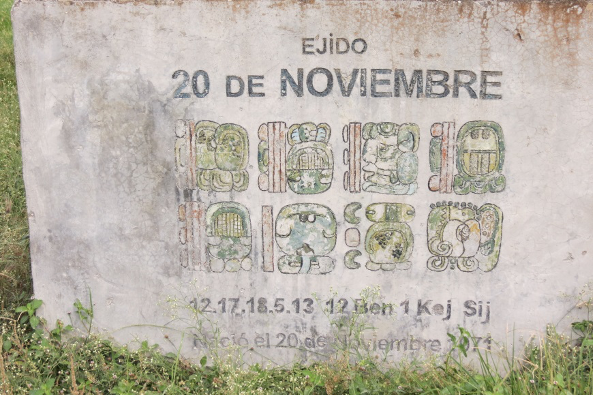
Ejido 20 de noviembre (photo courtesy of Margaret Jackson)
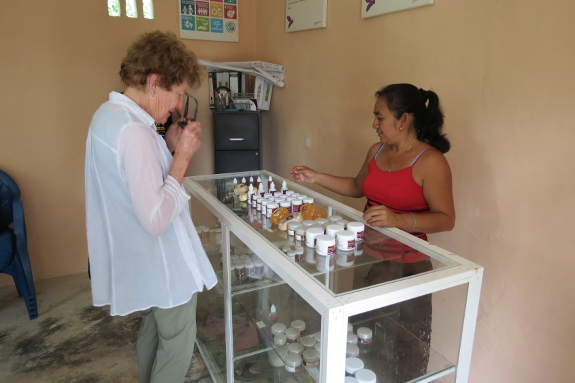
Member of the group purchasing items made from Melipona bee honey
(photo courtesy of Margaret Jackson)
The group stopped to visit the archaeological site of Kohunlich (300 BC – 1200 AD), famous for its large stucco masks of the humanized sun god. The site appears to have been a regional center which connected trade routes from Campeche through the Rio Bec region into the Petén region into Guatemala and Belize. The group stopped for lunch at Laguna Bacalar, a beautiful fresh water lagoon known for its turquoise and blue colors. The lagoon is 42 km long by 2 km wide and is fed by underground rivers - the same rivers that feed the intricate cenote system on the Yucatán peninsula.
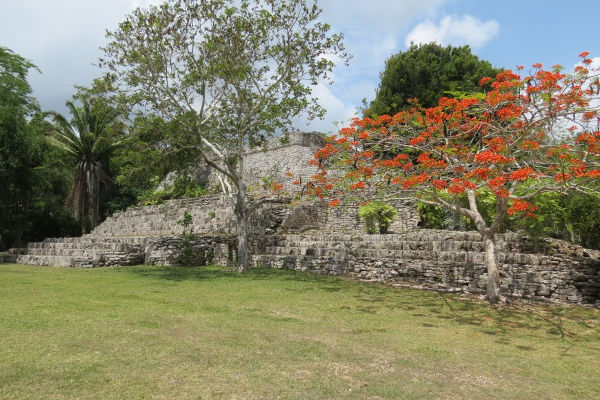
Archaeological site of Kohunlich (photo courtesy of Margaret Jackson)
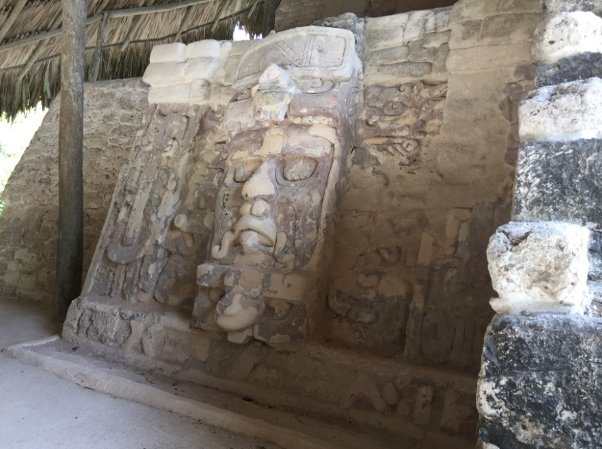
Stucco mask at Kohunlich (photo courtesy of Manon Robyn Côté)

Laguna Bacalar (photo courtesy of Manon Robyn Côté)
Day 9: Tulúm Having arrived at their destination, the last day of the tour was spent visiting the archaeological site of Tulúm (564 AD – 1550 AD), a Late Classic-Postclassic site built on the Caribbean coast. The site likely functioned as a port for the city of Cobá and was probably seen by Spanish explorers when they arrived on the Yucatán in 1511. Tulúm is a small but lovely site surrounded by a stone wall. One of its most famous buildings is known as the Temple of the Diving God. Another important building is the Temple of the Frescoes, which unfortunately are closed to the public. The group stopped for one last photo in front of El Castillo, overlooking the beautiful Caribbean Sea.
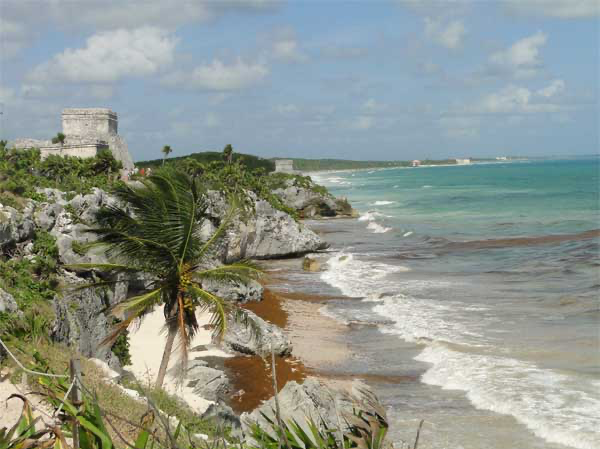
Tulúm archaeological site (photo courtesy of Manon Robyn Côé)

Temple of the Wind God, Tulúm (photo courtesy of Margaret Jackson)
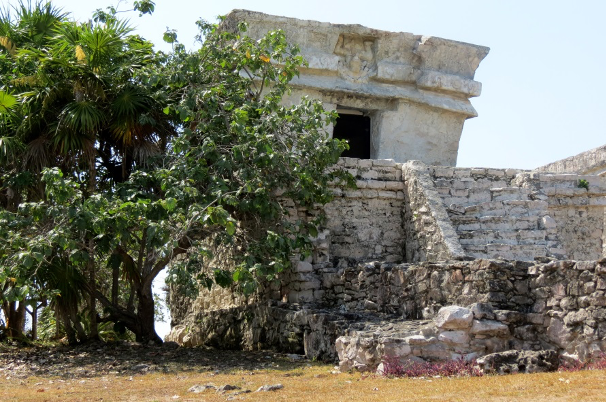
Temple of the Diving God, Tulúm (photo courtesy of Margaret Jackson)

Temple of the Frescos, Tulúm, (photo courtesy of Manon Robyn Côté)
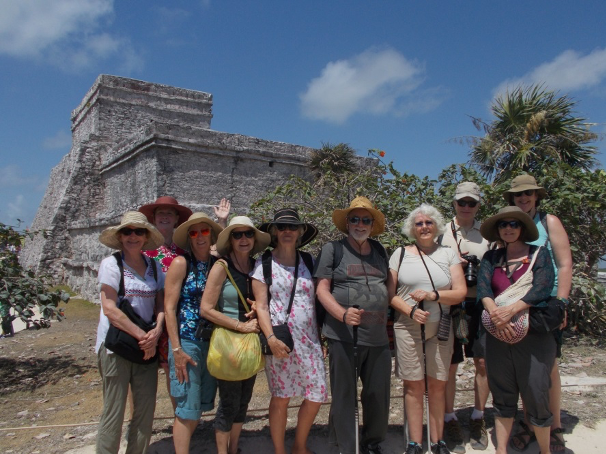
The group at El Castillo, Tulúm (photo courtesy of Manon Robyn Côté)
Day 10: Return home On the final day the group split up into smaller groups, with some people staying in Mexico for a few extra days and others taking the van to the Cancún airport for the return trip home.
Reflections
From Group Member Nancy Lombardo: “I really enjoyed the lecture on the Zapatistas. Very interesting and well organized. I liked the tour of San Cristobal and meeting the woman who does archaeological preservation. The church in San Juan Chamula was amazing! Visiting the home of the family of women weavers in Zinacantán was fun. I loved going to the small shop in 20 de noviembre and buying crafts from the Mayan woman there. Of course, the biggest highlight was all of the Maya sites.”
From Group Member Marie Trigg: “Great trip to see the Maya historical sites, sites that are seen by only a few…..We visited many places that would probably have been inaccessible to me if I was traveling solo. Thoroughly enjoyed the activities. I enjoyed our time in San Cristobal, the visit to the restored church and the textile museum. I enjoyed visiting the historical sites.”
From LAII Program Manager Manon Robyn Côté: “This was an excellent trip which allowed community members to travel to out-of-the-way places that not many people get to visit, in fact at many of the sites in Campeche we were practically the only visitors, which allowed us to explore the sites more freely. One of the most important takeaways from the trip was just that – the threat of what President Andrés Manuel Obrador’s Maya Train will do to the region if the Mexican government follows through with building the train on basically the same route our group took, and then going north to the more well-known sites of Chichen Itzá and Uxmal and Sayil in the Puuc region – it will destroy these sites and turn them into a Disneyland-like atmosphere, which we caught a glimpse of at Tulúm. Already they have quadrupled entrance fees into some of the northern sites in order to fund the construction of this train. This train is so controversial because although it would bring economic development to the region, it would pose a severe threat to the fragile archaeological and ecological sites on the peninsula and would infringe upon several Maya and Zapatista communities who do not want governmental interference and are staunchly autonomous. Our group was very fortunate to see so many of these Maya ruins before they are precariously threatened in the coming years.”
From Professor of Pre-Colombian Art History Dr. Margaret Jackson: “The 2019 Maya Art and Archaeology tour was absolutely memorable, with an extraordinarily well-planned itinerary that went off without a hitch. This is exactly the kind of high-profile educational opportunity that the LAII should encourage and promote. In my conversations with various students and faculty, I noted that the majority had seen our LAII travel posters and many expressed interest. UNM offers various ways to help students find funding for travel. In the future, I hope we can increase ways to support student participation. My own experience as faculty co-leader was very positive, ultimately feeding into courses that I will teach in the upcoming semester. Although travel programs do not necessarily generate high profit margins, they do generate public enthusiasm for Latin American Studies and awareness of the Latin American Iberian Institute as a dynamic entity on campus – something of intangible value contributing to the Institute’s viability at UNM.”
